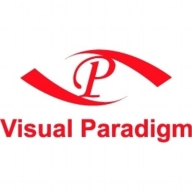

Camunda and Visual Paradigm compete in the business process modeling and management space. Camunda appears to have a slight edge due to its open-source nature and strong standards support, which offer flexibility and integration options.
Features: Camunda provides lightweight architecture, scalable BPM engines, and extensive support for BPMN, CMMN, and DMN standards. Its open-source nature allows for extensive customization and easy API integration. Visual Paradigm is known for its broad modeling toolset, supporting UML and BPMN, and its comprehensive simulation features.
Room for Improvement: Camunda users point out the need for better form-building capabilities, a more intuitive user interface, and enhanced community support. Visual Paradigm could improve its performance with larger models, refine its user interface usability, and offer broader integration options with other tools.
Ease of Deployment and Customer Service: Both Camunda and Visual Paradigm offer flexible deployment options, including on-premises and cloud solutions. Camunda's customer service receives mixed feedback, while Visual Paradigm is often praised for accommodating support, though it also could improve technical support accessibility.
Pricing and ROI: Camunda offers open-source options with competitive pricing but enterprise licensing can become expensive as companies scale. It is generally seen to provide positive ROI. Visual Paradigm offers flexible pricing tiers, including affordable subscriptions, and is considered accessible and adaptable to different needs.
The product did what it was supposed to do for the documentation development I was engaged in.
On a scale of 1 to 10, I would rate them a 10 for support.
AWS provides the best support, followed by Microsoft, and then Google.
They provide better support for the enterprise edition.
The tool was easy enough to use.
We didn't use customer service extensively, but our questions were answered when needed.
Camunda offers a high level of scalability, especially when using its SaaS model, which manages and scales implementations automatically.
It allows for easy scaling, especially with ECS service configurations.
They have that REST layer, REST APIs layer that makes it easy to integrate and make it part of a microservices ecosystem and APIs.
There haven't been any significant outages in my experience with Camunda.
We were not really concerned about the performance on the process itself because it was super simple, super straightforward, and it did not present itself as a bottleneck, nor did we feel it was adding additional time in the execution.
Since they made the move to cloud deployment in a more SaaS-oriented way, they do not invest too much in the community version.
There is an issue where, in some situations, I need to scale up by observing both CPU and memory usage of containers, yet under the current options available at Amazon, this is not possible.
More open documentation would be beneficial to understand the deployment process better and facilitate easier setup.
The product can always get better as the industry changes.
For some services, such as hosting databases, Google is really expensive.
There is a licensing cost for using the SaaS model and Enterprise edition of Camunda.
The free version of Visual Paradigm does not incur any setup costs and offers a set of usable features.
I purchased Visual Paradigm on my own, and it was competitively priced.
There was no need to deploy and run heavy and large tools and frameworks and middlewares, allowing us to embed the process engine inside our Java applications.
EC2 makes scaling horizontally incredibly easy, especially when working under the ECS service.
The biggest difference between Camunda and Bonita might be that Camunda is simpler and more flexible for setting.
In other drawing programs, if I moved a box, I had to move the arrow, but Visual Paradigm handled those tasks automatically.
It is user-friendly, and as you become more familiar with its deep features, you might consider upgrading to the paid version for more complex projects.
| Product | Market Share (%) |
|---|---|
| Camunda | 11.3% |
| Visual Paradigm | 5.1% |
| Other | 83.6% |


| Company Size | Count |
|---|---|
| Small Business | 42 |
| Midsize Enterprise | 15 |
| Large Enterprise | 29 |
| Company Size | Count |
|---|---|
| Small Business | 15 |
| Midsize Enterprise | 5 |
| Large Enterprise | 7 |
Camunda revolutionizes process orchestration by enabling seamless automation and integration with AI, human tasks, and existing systems while ensuring security and governance.
Built for collaboration between business and IT, Camunda empowers organizations to manage complexity, boost efficiency, and maintain competitive advantage. With a clientele of over 700 top organizations like Atlassian, ING, and Vodafone, Camunda is a trusted partner in designing, orchestrating, automating, and refining critical business processes to accelerate digital transformation. Its open-source nature, ease of use, and REST API integration make it a versatile choice for various needs.
What are Camunda's key features?In banking, Camunda automates processes and manages transactions, while in telecommunications, it optimizes service orders. Governmental and public sectors benefit from workflow automation. Organizations often use either the enterprise edition or the open-source version to create APIs and manage business rules effectively.
We monitor all Business Process Design reviews to prevent fraudulent reviews and keep review quality high. We do not post reviews by company employees or direct competitors. We validate each review for authenticity via cross-reference with LinkedIn, and personal follow-up with the reviewer when necessary.